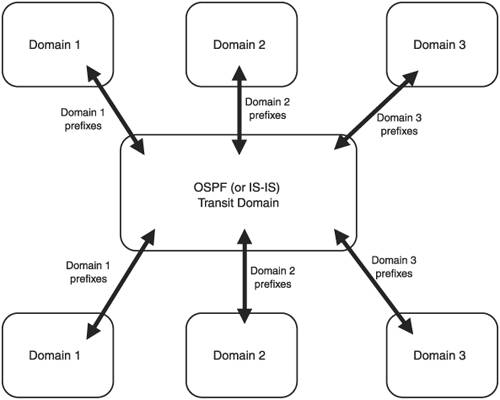Section 10.3. Route Tagging
10.3. Route TaggingBoth OSPF and IS-IS allow the association of a value called a route tag with external prefixes. You can think of route tags as a protocol extensibility feature in that they enable you to arbitrarily assign some administratively meaningful value to external prefixes to associate them with some group that you define. You can then create routing policies that act on the external prefixes according to their assigned tags. In this, route tags for IGPs[3] serve the same purpose as BGP community attributes.
The Route Tag field is provided in OSPF types 5 and 7 LSAs (Figure 10.10). A Route Tag field is also provided by an IS-IS type 1 sub-TLV (Figure 10.11), which is in turn carried by type 135 Extended IP Reachability TLVs.[4] In both cases, the External Route Tag field is 32 bits, so the tag value can be any number in that range.
Figure 10.10. The External Route Tag field in OSPF AS-External LSAs allows an arbitrary 32-bit number to be assigned to an external prefix. Figure 10.11. Sub-TLV 1, carried in Extended IP Reachability TLVs, allows an arbitrary 32-bit number to be assigned to an external prefix. The most common application of route tags is in complex route redistribution policies. Route tags are used when it is impractical to identify prefixes using prefix lists or route filters, either because there are so many prefixes to be identified that the list would be unmanageably long, or because you are uncertain what prefixes need to be identified. You can tag prefixes at their point of originby incoming interface, advertising neighbor, or redistribution point, for exampleand then apply polices to the prefixes elsewhere in your network by identifying the tag, rather than individual prefixes. Figure 10.12 shows an example of where route tags can prove useful. Here, an OSPF domain is the transit network for three external routing domains.[5] The prefixes of each of the three domains are redistributed into OSPF, but must be sorted out when they are readvertised back to the external domains: Only domain 1 prefixes must be advertised to domain 1, only domain 2 prefixes are advertised to domain 2, and so on.
Figure 10.12. The prefixes of each of the three external domains can be distinguished within the OSPF transit domain by tagging them as they are redistributed into OSPF. As a prefix is redistributed into OSPF, it can be tagged with an identifier that associates it with the proper domain. A policy can then be created that distinguishes the prefixes based on their assigned tags, and advertises only the correct prefixes to each external domain. Another application for route tags is for leaking prefixes from one IS-IS level to another, in which you want to leak some prefixes but not others. Polices can be used to tag prefixes at their origin, identifying them with administratively defined groups. Other polices can then be implemented at level boundaries that identify the prefix groups, by tags, that are to be leaked and the prefix groups that are to be suppressed. |
EAN: 2147483647
Pages: 111

